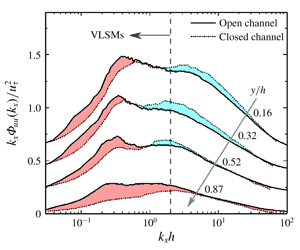Article contents
Contributions of very large-scale motions to turbulence statistics in open channel flows
Published online by Cambridge University Press: 31 March 2020
Abstract

Time-resolved particle image velocimetry measurements were performed in smooth-walled open channels to investigate the contributions of very large-scale motions (VLSMs) to the turbulence characteristics in open channel flows. The focal point is to clarify the free surface effects on the characteristics of VLSMs and the contributions of VLSMs to the unique statistical features in open channel flows (i.e., the turbulent kinetic energy (TKE) redistribution and smaller wake strength of the mean velocity profile). The resulting wavelength of VLSMs in present smooth-walled open channels is approximately  $20h$ (
$20h$ ( $h$ is water depth), which is comparable to that in pipe and closed channels while smaller than that in rough-walled open channels, and they are shown to make a great contribution to turbulence statistics with over 50 % of streamwise turbulence intensity, Reynolds shear stress and negative net force coming from VLSMs in the outer layer. Compared with other wall-bounded flows, VLSMs maintain higher strength in the outer layer of open channel flows with non-negligible strength even in the near surface region (
$h$ is water depth), which is comparable to that in pipe and closed channels while smaller than that in rough-walled open channels, and they are shown to make a great contribution to turbulence statistics with over 50 % of streamwise turbulence intensity, Reynolds shear stress and negative net force coming from VLSMs in the outer layer. Compared with other wall-bounded flows, VLSMs maintain higher strength in the outer layer of open channel flows with non-negligible strength even in the near surface region ( $y\sim >0.8h$), indicating that the free surface seems to sustain/promote VLSMs. This strength difference of VLSMs closely relates to the TKE redistribution and smaller wake strength of the mean velocity in the outer layer of open channel flows. The higher streamwise turbulence intensity is mainly contributed from the higher strength of VLSMs therein. The decelerating role of VLSMs combining with their higher strength is vital for shaping the mean velocity profile, which therefore is speculated to make a great contribution to the smaller wake strength phenomenon.
$y\sim >0.8h$), indicating that the free surface seems to sustain/promote VLSMs. This strength difference of VLSMs closely relates to the TKE redistribution and smaller wake strength of the mean velocity in the outer layer of open channel flows. The higher streamwise turbulence intensity is mainly contributed from the higher strength of VLSMs therein. The decelerating role of VLSMs combining with their higher strength is vital for shaping the mean velocity profile, which therefore is speculated to make a great contribution to the smaller wake strength phenomenon.
- Type
- JFM Papers
- Information
- Copyright
- © The Author(s), 2020. Published by Cambridge University Press
References
- 35
- Cited by


